What are the advantages and disadvantages of anaerobic digestion vs composting is a question asked by a large number of people.
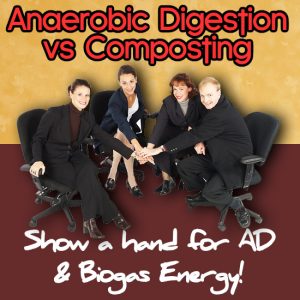
Many of our readers who are familiar with composting, but who are thinking more widely about the subject of recycling organic waste and have just heard about Anaerobic Digestion want to know the anaerobic digestion pros and cons.
If this is you, read on while we answer the question: “Which is best, anaerobic digestion, or the much simpler and lower capital cost method of composting?”
First of all the two processes are very much the same. The crucial difference is that composting is the decomposition of organic matter in the presence of air (oxygen) and anaerobic digestion (AD) is the decomposition of organic matter, without air (and most importantly oxygen) present.
[boomdevs_toc]
Now we make the case for each process by listing the advantages and disadvantages of anaerobic digestion vs composting below:
Advantages of Anaerobic Digestion
- It is a net energy-producing process that produces renewable energy in the form of biogas.
- It sanitizes the feedstock/ waste which is put through it, as long as the temperature is held above a required temperature for a pre-defined time period (pasteurized).
- It reduces odour below unprocessed waste odour levels. an example of this is the comparison between manure spreading and the same material spread after anaerobic digestion when it is known as “digestate”.
- It is much less likely to cause environmental pollution than spreading untreated organic waste on land.
- Provides for efficient resource recovery, and conservation of non‑renewable energy sources.
- Lower sludge mass generation when used as a primary water treatment method compared to an aerobic system applied to the same contaminant concentration and flow.
- The effect of the fertilizer is longer lasting than for untreated organic waste.
- It can be upgraded (purified to almost pure methane) to become “biomethane” which has many advantages over raw biogas. Not least is the fact that when it is pressurized to become bioLNG it is one of the few ways to decarbonize the transport sector.
- The process produces some carbon dioxide in addition to methane which can be purified and sold as a valuable product.
- Anaerobic digestion is likely to produce less microplastic pollution than anaerobic digestion. (See the section below titled; “The Fate of Plastic”).
Disadvantages of Anaerobic Digestion
- When carried out at a commercial scale on farms and at wastewater treatment works (WwTWs) it requires a high level of investment in large tanks and other process vessels.
- If run inefficiently AD can cause an odour nuisance.
- Does not convert as large a proportion of the carbon in the biomass to biogas as can be achieved using gasification.
- It takes longer to start up the process due to the slow growth rate of the methane-producing organisms as compared to aerobic systems.
- In some applications has higher buffer chemical dosing requirements for pH control to keep the pH for AD within the range of 6.5–8.
- Nutrients removal is not as efficient as in aerobic treatment if is used as a water treatment process. Invariably a post‑treatment process will be necessary before any discharge to a watercourse. For such discharges, a secondary process stage will be needed such as membrane filtration, or even further aerobic treatment, in order to meet the river, ditch, or stream discharge consent requirements and protect the aqueous environment.
- The digestate output contains ammonia which when it is spread on land needs care to prevent ammonia gas from causing air pollution.
Advantages of Composting
- Lower initial capital investment is needed to start a composting facility than is needed for an AD Plant.
- A slightly lower level of training is needed to run a composting plant than is required for an AD Plant.
- It produces a solid output/ fertilizer only. For some, this will be an advantage, but in general, this digestate product is a neutral factor, neither positive nor negative for composting.
- It has the same advantages as for AD (items 3 to 6 inclusive) over spreading untreated organic waste material on land.
Disadvantages of Composting
- Pasteurisation is Less Reliable: If the composted materials or digested outputs contain waste types such as animal or food waste there is a risk that diseases (for example “foot and mouth”) may be spread in the compost (or digestate) if it does not get hot enough throughout the compost pile for long enough to kill the dangerous organisms.(See our grey box below which explains the difference between “green” and “food” waste compost.)In circumstances where pathogenic organisms may be present, in many countries (such as the UK and EU) the “Animal By-products regulations” (ABP Regs.) must be complied with for all commercial compost sales/ spreading on land.
It is necessary to pasteurize both composted material and the digested output as well, to ensure that all infectious agents have been effectively removed.
Commercial composting companies and Anaerobic Digestion Plant owners ensure that they meet the relevant regulations by applying the PAS 100 code for Quality Compost.
During composting this is done by ensuring that it composts rapidly and raises its own temperature, through the heat produced during composting. The required hot temperature must be held constant for a stated minimum time period.
Ensuring that every batch self-sanitises itself this way requires very good operating practice. and detailed monitoring to demonstrate successful pasteurisation to the local environmental regulating body. This is much harder during composting than during anaerobic digestion because in an AD plant, the digestate is heated within a tank and mixed throughout the tank.
By comparison at a composting plant, the windrow edges may not reach the required temperature and with varying quality batches, raising the temperature to the required level is dependent on the self-heating effect of the composting process itself. For compost pasteurisation to be effective it depends on a high rate of energy within the composting material itself in every batch, and thus the required temperature can be hard to achieve.
3. Composting Requires Net Input of Energy: This disadvantage is the biggest disadvantage of composting! Composting requires the input of quite large energy inputs to fuel and operate the equipment needed to aerate and turn the compost piles.
By comparison, anaerobic digestion wins hands-down for “greenness” by providing its own power. it does not need additional power from fossil fuels. In the future, even the collection vehicles will be powered by methane from the AD process.
4. Company Sustainability: Composting makes no contribution to reducing the carbon footprints of the businesses that use the composting process.
By comparison, AD Plants can assist businesses by reducing their carbon footprint.
4. Odour Risk: Like AD, if run inefficiently, composting can cause an odour nuisance.
The Difference Between “Green” and “Food” Waste Compost
Green and food-derived composts can be used in landscape and regeneration projects. Green compost is solely derived from garden waste and comes from sources such as domestic gardens, municipal parks and recreational areas, and is collected separately from other waste streams.
This compost is usually produced outdoors in open windrows.
Food-derived compost contains a mixture of garden and food waste collected separately from other waste streams from households and businesses. This compost is produced in enclosed in-vessel systems and must be compliant with Animal By-Products Regulations (ABPR), as well as the relevant waste legislation. via wrap.org.uk
We also found the following blog articles which discuss anaerobic digestion vs composting as follows, which you might find interesting to read:
Anaerobic Digestion – an Alternative to Composting
Similar to composting, in AD bacteria consume organic waste such as food scraps, silage, and animal waste and generate an environmentally benign byproduct that can be used as a natural fertilizer. Unlike composting, however, AD also produces biogas, which consists of about 2/3 methane (CH4). Natural gas is methane with a small amount of other trace gases, so biogas can be used as fuel like natural gas. … via ADAlternativeToComposting
What's the Difference Between Anaerobic Digestion and Aerobic Decomposition
Yes, one is with and the other without oxygen, and both divert waste from the landfill—but in terms of the end products, what is the advantage of anaerobic digestion? Simply put, does society face a shortage of compost or renewable energy?
In San Francisco, the green compost bins are ubiquitous. Even the food trucks are required to place bins alongside their trucks for compost, recyclables, and trash. Result: the city is diverting an enormous amount of trash from the landfill to help meet its zero-waste goal and producing lots of compost in the process – a process which also produces a lot of carbon dioxide, “the primary greenhouse gas emitted through human activities,” according to the EPA.
A few cities are taking an alternative, more expensive approach to diverting this organic waste called anaerobic digestion and in the process also producing biomethane that is captured for use in electricity generation or used as a transportation fuel. And from a “carbon intensity” perspective, this biogas, also called renewable natural gas, scores at the bottom of carbon intensity chart for California's Low Carbon Fuel Standard, i.e. it is one of the cleanest of all transportation fuels…. Pop Quiz Difference
Anaerobic Digestion vs Composting: Another Way to Compare the “Aerobic” Process of Composting with “Anaerobic” Digestion is to compare the simplified process diagrams which we show below:
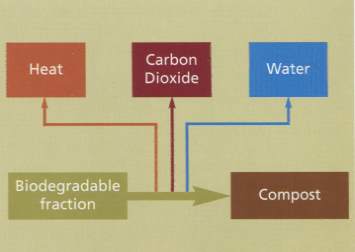
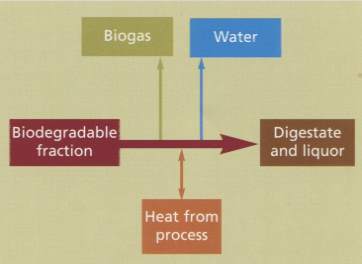
(Source: Advanced Biological Treatment of Municipal Solid Waste, Defra UK, 2007)
The Fate of Plastic: Anaerobic Digestion vs Composting
It is not widely known that although both anaerobic digestion and composting can easily be done in a manner which creates large amounts of microplastic which is spread on agricultural land to be washed into global oceans.
Composting is inherently worse for causing plastic pollution than anaerobic digestion.
The simple reason for this is that:
- Anaerobic digestion plant operators have to ensure that as much plastic as possible is removed from their digester waste feed flow to a high standard or risk their digester tanks becoming useless due to the build-up of plastic in them
- Composting plant operators seldom if ever remove the plastic bags etc in their green compost supplies because they are permitted by the regulations not to have to remove it. Instead, they simply shred it into the tiny microplastic which is so small that gardeners will not see it. Nevertheless, they are making the problem of microplastic for the environment much worse by doing so, and very few people are even aware of this.
Anaerobic Digestion vs Composting – Conclusion
There are advantages to both anaerobic digestion and composting, and certainly applying either before green garden waste, or other organic waste is spread on the land, is better than not processing these materials at all.
On balance, the preferred process is anaerobic digestion.
The primary reason that anaerobic digestion is considered more sustainable than composting is that composting requires an energy input to carry out the process. The energy is used in the power needed to turn the compost piles during composting.
The fact that anaerobic digestion:
- produces biogas (a renewable energy source that burns cleanly), and that
- biogas plants make more energy than they consume to operate,
are generally the factors that make anaerobic digestion the best, most sustainable, option.
Footnote:
Energy Balance Benefits and Feedstock Issues
Although composting (IVC or in Windrows) and anaerobic digestion (AD) treat similar wastes, they are in fact complementary and not competing technologies.
From an energy consumption and greenhouse gas emission reduction point of view, there is merit in having an AD stage first followed by composting.
The benefit of an AD process is that it produces energy in the form of biogas, whereas composting will generally use energy in the processing stages, in aerating the waste and treating any leachate arising from the process. Although the AD liquor which comes out of an AD plant often needs treating, the energy required is available from the biogas.
The digestate from AD often needs to be matured by composting before it can be applied to land. This point is important to be aware of when comparing anaerobic digestion vs composting because the best use of composting is to use it in combination with anaerobic digestion. In this way, they compliment each other for the best possible outcome.
Since the AD process has reduced the total amount of material (which has been removed as gas), less energy should be required than if the whole amount of waste was treated through composting.
Notwithstanding these issues, some proportions of materials are inherently better suited to either composting or anaerobic digestion.
For example, high proportions of green waste with much bulky wood material is better suited to composting processes as it is easier to handle and has less gas production. Conversely, high proportions of kitchen waste are better suited to AD processes as the gas production potential is
higher and odour control is easier to achieve.
We hope that you found this article useful. If so, and you have a moment to do this. We would greatly appreciate your comments.

FAQs on Anaerobic Digestion vs Composting
1. How are anaerobic digestion and composting similar and different?
Both are processes for recycling organic waste. The main difference is that composting is done in the presence of air (oxygen), while anaerobic digestion occurs without air (particularly oxygen).
2. What are the main advantages of anaerobic digestion?
Anaerobic digestion is a net energy-producing process, generating renewable energy in the form of biogas. It sanitizes the waste and reduces odours and environmental pollution. It also has long-lasting fertilizing effects and can produce carbon dioxide, a valuable product.
3. What are the downsides of anaerobic digestion?
Anaerobic digestion requires significant investment, can cause odor issues if run inefficiently, and doesn't convert as large a proportion of the carbon in the biomass to biogas compared to gasification. It also needs careful pH control and often requires post-treatment processes for nutrient removal.
4. What are the advantages of composting?
Composting requires lower initial capital investment and less training compared to anaerobic digestion. It reduces environmental pollution and diseases spread through untreated organic waste and produces a solid fertilizer output.
5. What are the disadvantages of composting?
Composting can spread diseases if it contains animal or food waste and it doesn't comply with certain regulations. It requires significant energy inputs, contributing less to reducing carbon footprints. Like anaerobic digestion, inefficient composting can cause odour problems.
Commercial composting is a net user of energy which is used to turn the compost piles for better maturation and the screens which shred the compost to make it suitable for use. This equipment could be converted to use electricity or hydrogen as its fuel source but currently, petrol and oil-based fuels are used which adds to the carbon emissions from composting.
If composting is done badly the unturned piles may become anaerobic which will result in the worst possible outcome for climate change when methane is generated and emitted directly to the atmosphere.
UK research conducted in the 1990s showed that governments that encourage garden composting risk being found to encourage carbon emissions. The fact is that when the public conducts composting in their back gardens they simply don't have the skills necessary to avoid anaerobicity and the resulting highly damaging methane emissions. This important point is seldom made when comparing anaerobic digestion vs composting and yet is very important.
6. Can composting and anaerobic digestion be used together?
Yes, they can be complementary technologies. From an energy consumption and greenhouse gas emission reduction perspective, having an anaerobic digestion stage first followed by composting has merit. The energy required for treating the digestate from AD can be supplied by the biogas produced during the process.
7. What types of waste are best suited to composting and anaerobic digestion?
Green waste with much bulky wood material is better suited to composting processes, as it's easier to handle and has less gas production. Kitchen waste, on the other hand, is better suited to anaerobic digestion processes due to its higher gas production potential and easier odor control.
8. What is the overall conclusion when comparing anaerobic digestion and composting?
The preferred process is anaerobic digestion, mainly because it is a net energy-producing process, whereas composting requires energy input. The ability of anaerobic digestion to produce biogas, a renewable and clean energy source, makes it the more sustainable option.
This article was first published on 23 Oct 2015. Previously dated September 2021.


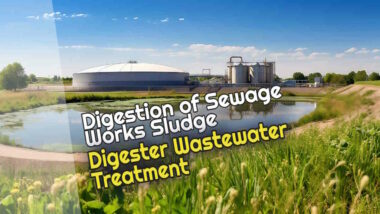
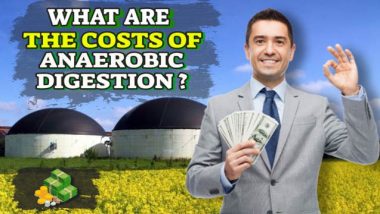

I liked your site a lot. I’m taking an online course on Water Quality Technology from the UW-Moraine Park and I found this very useful in helping me write a paper on alternate methods of sludge stabilization. Thanks.
Thanks for your feedback. It is appreciated, and it is good to hear that you found some useful information for your paper.
I totally disagree with the assumption that aerobic digestion is more expensive, which is far from the truth. Shallow open pits can used in rotation for composting, where earth worms and bacteria will break down organic materials producing valuable organic manure. In most warm climates, aerobic composting can be completed within 2-4 weeks.
why aerobic degradation is faster than anaerobic degradation????????????
I think that the normally given answer the AD experts will give you is that the methanogenic archaea that do the anaerobic degradation, are a lot slower growing (metabolising) than their aerobic equivalents. I hope that helps you.
The reason that aerobic degradation is faster than anaerobic degradation is that the anaerobic organisms (methanogens) that do the degrading in anaerobic systems are slow growing at normal ambient (atmospheric) temperatures. They grow faster at higher temperatures. If you look on the web you will see that in hot tropical climates it is much more common to see small domestic biogas plants. Those un-insulated tansk don’t work so well in cooler climates.
tanks alot it of great help to my project work
Your writing is very well received by me. At first my view was to say that anaerobic digestion was not preferable to composting, now I see that you are telling us the opposite. The fertiliser is a much needed product for farmers I am sure.
The Advantages of Anaerobic Digestion are many. Thanks to Brazilian-German Project on energy from Biogas – PROBIOGAS (DKTI). In May 2016, a biogas project based on agricultural residues with a capacity of about 21 MW won an energy auction for the first time. The energy will be priced at EUR 70/MWh, and it will start producing electricity from 2021.
Hi. Thank you for the informative writing and article. Some people are using the heat generated from composting to heat water/interior spaces, so perhaps that could be added to the advances of composting.
Hello there,
Would like to know if you would have any interest to have your website here at anaerobic-digestion.com promoted as a resource on our blog. If so mail me to the email I just used for this post.
We are in the midst of updating our broken link resources to include current and up to date resources for our readers. Our resource links are manually approved.
If you may be interested please in being included as a resource on our blog, please let me know.
Thanks
Baz – Yes. I mailed you.
what if the organics are out of a MSW material recovery facility with contaminants like glass, plastics etc.
can I in this case use this contaminated organics in AD or compost ?
In many countries with good regulation for healthy food production there will be rules for farmers to comply with.
The use of what was originally from an “MSW material recovery facility” may not be allowed if the compost is to be used in agriculture. It will be expected to have heavy metals too high for this.
The regulations in the UK, for example, require that the compost which is spread for crop use, will not damage the land for food production.
Depending on the source of any compost/ matured digestate there may be any one of many contaminants which must not be allowed to build-up in the soil. Before, those are spread on the fields the compost must be tested and shown to comply with the PAS100 standard for the materials in the compost. Plus, the required conditions of pasteurisation must also be complied with.
“MSW material recovery facility” organic waste fraction may also contain waste covered by the Animal By-products Regulations.
You mention glass and plastics contamination. These are not specifically banned in the UK. But, many people have said that the UK regulations are out of date and need updating to specifically prohibit plastics in compost spread on agricultural land.
It is very misleading to you say compost need to be pasteurised before it can be used. This shows a basic misunderstanding how and why compost is made and used. You also ignore the reduction is emissions from reduced artificial fertiliser use.
Colin. I think that you needed to read it more carefully, but maybe the fact that I was referring to commercial composting, not garden composting, was not as clear as it could have been. So, I have updated the text to make it clear that my comparison was being made for a disadvantage of food waste composting and mixed food and household waste, and not solely “green” waste.
Anaerobic digestion also results in reduced artificial fertiliser use so I don’t see why it should be included in a comparison article?
It all depends where are you going the composting. If you are doing Home Composting Aerobic is best.
Anaerobic creates foul smell and one is dissuaded in doing composting itself. For large community projects, AD could be ok.
The benefits of anaerobic digestion include the formation of biogas and fertiliser, the decrease of greenhouse gas emission through integrated treatment of various organic waste and wastewater, and the reduction of solids to be handled. The ability to kill off pathogens is dependent on factors like temperature and, finally, process stability. Although it has its uses, anaerobic digestion also has drawbacks, thus proper mechanisms for recycling the energy it generates must be put in place. Also, I read that sulfur presents a danger to methanogenic bacteria because of their extreme sensitivity to it. Where is the sulfur?
While it’s clear that both methods have their merits, the article seems to lean towards anaerobic digestion as a more sustainable option primarily due to its energy-positive nature.
However, the high initial investment, longer start-up process, and certain pollution concerns like ammonia emissions from digestate are significant challenges that need to be addressed.
The text exaggerates the risk of disease spread without acknowledging the guidelines and best practices that, when followed, they do ensure safe and effective composting.